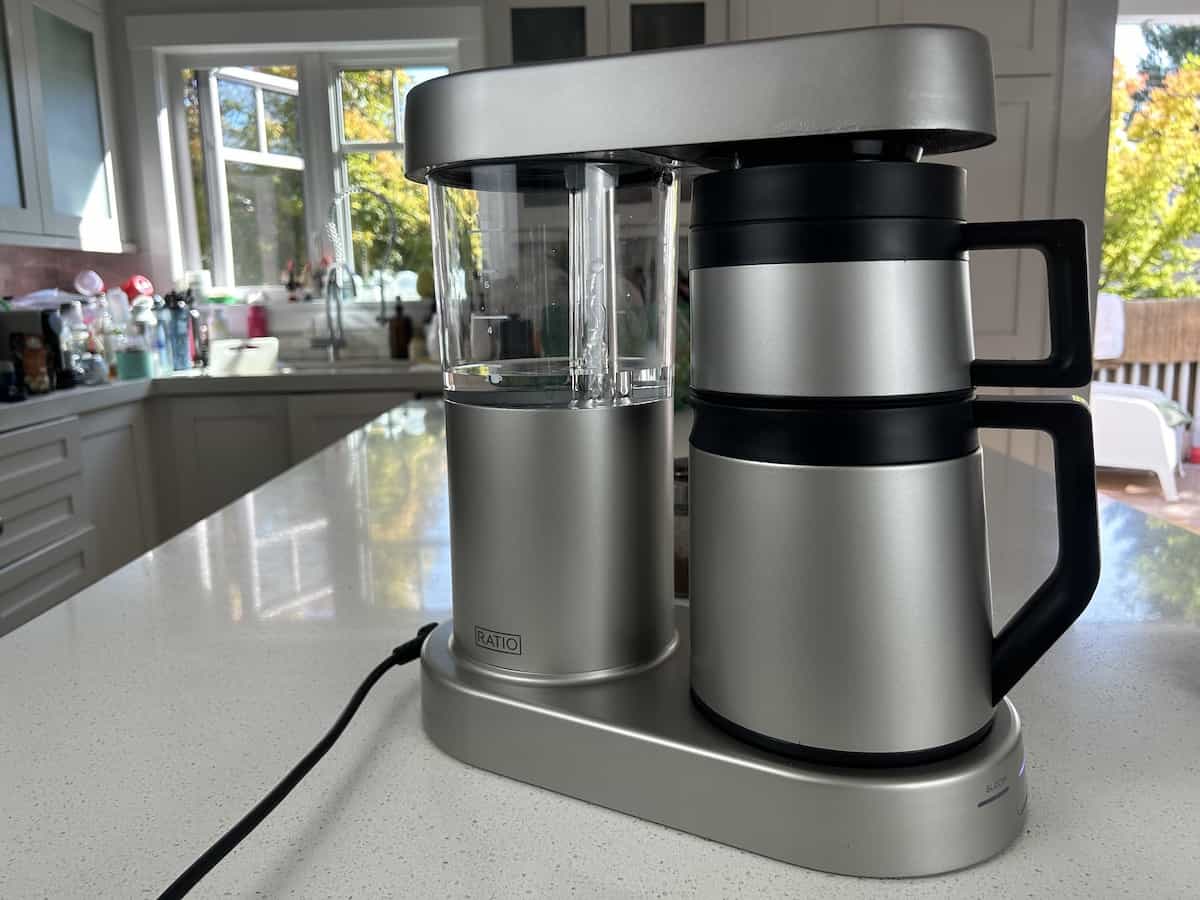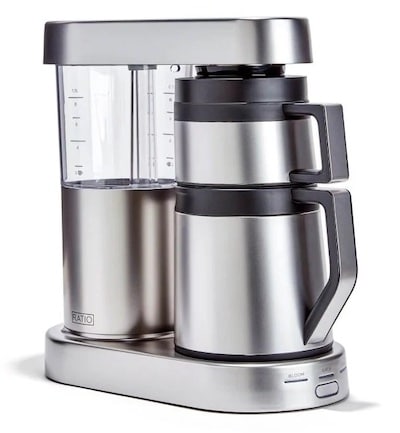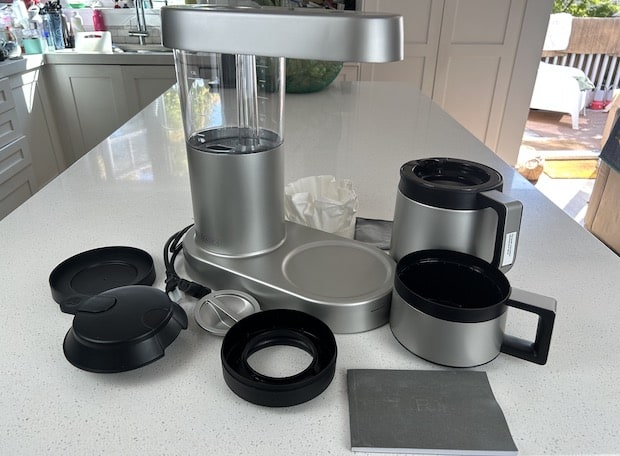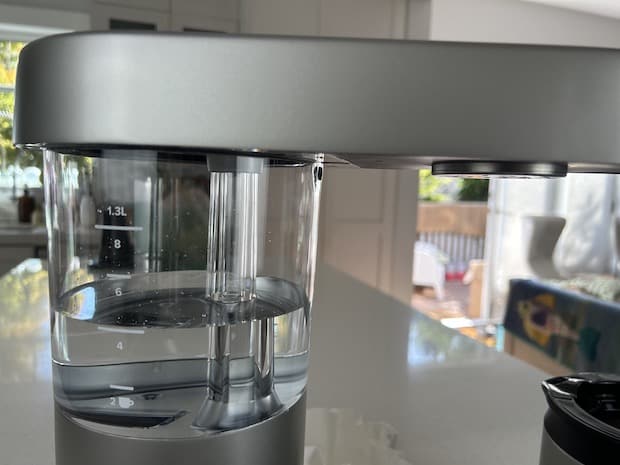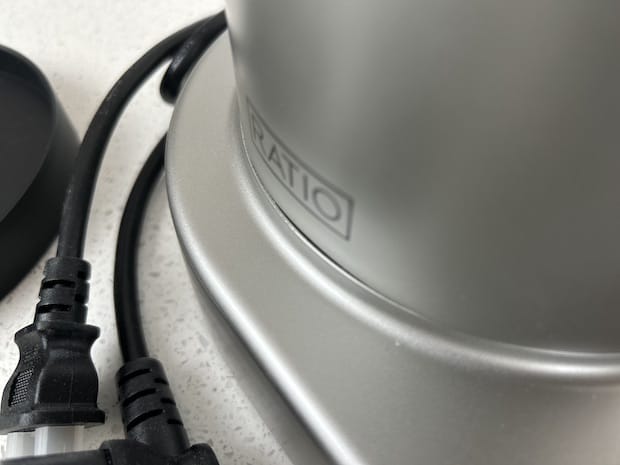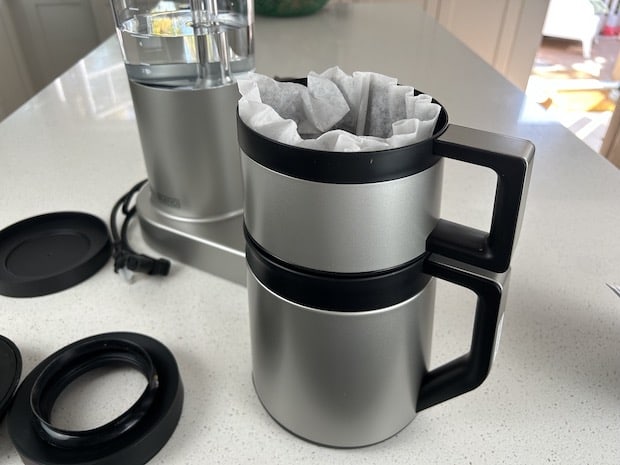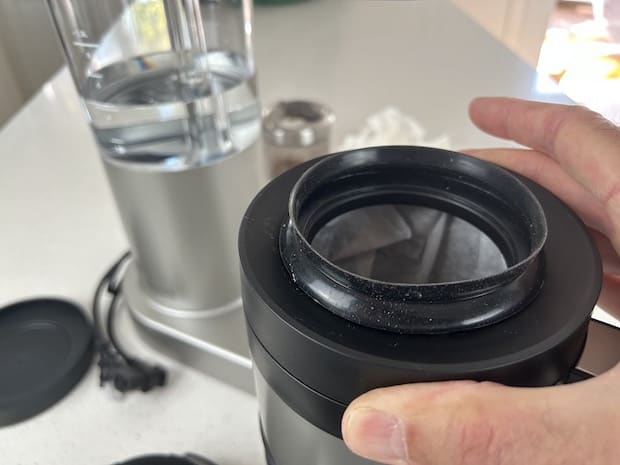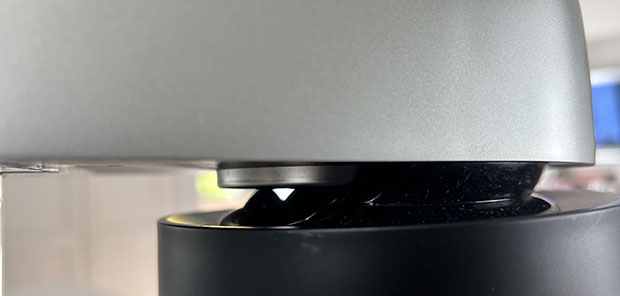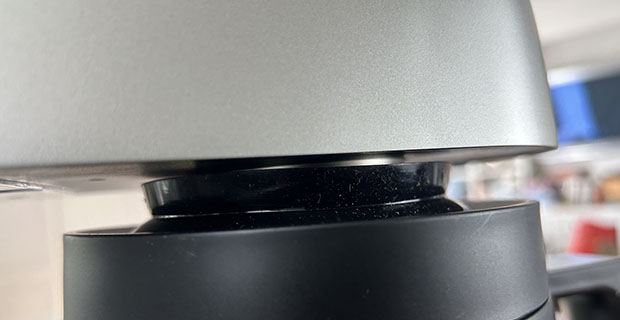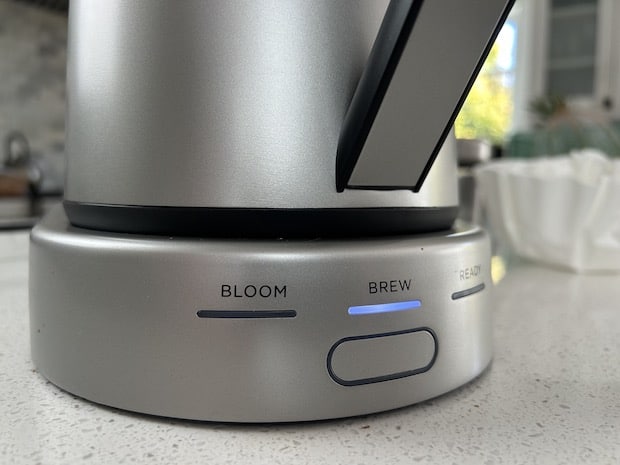Just so you know, as an Amazon Associate we earn from qualifying purchases made via bold red links, buttons or images.
Last Updated on November 24, 2024
You’ve set your sights on the Ratio Six coffee maker.
Smart choice. Embarking on the journey of premium coffee brewing is always exhilarating, and the Ratio brand has made quite a splash with their offerings. You’ve likely heard of their flagship, the Ratio Eight. That brewer is as much an art piece as it is a coffee powerhouse.
But now, with the Ratio Six making waves, you may be wondering if it’s the right brewer for you.
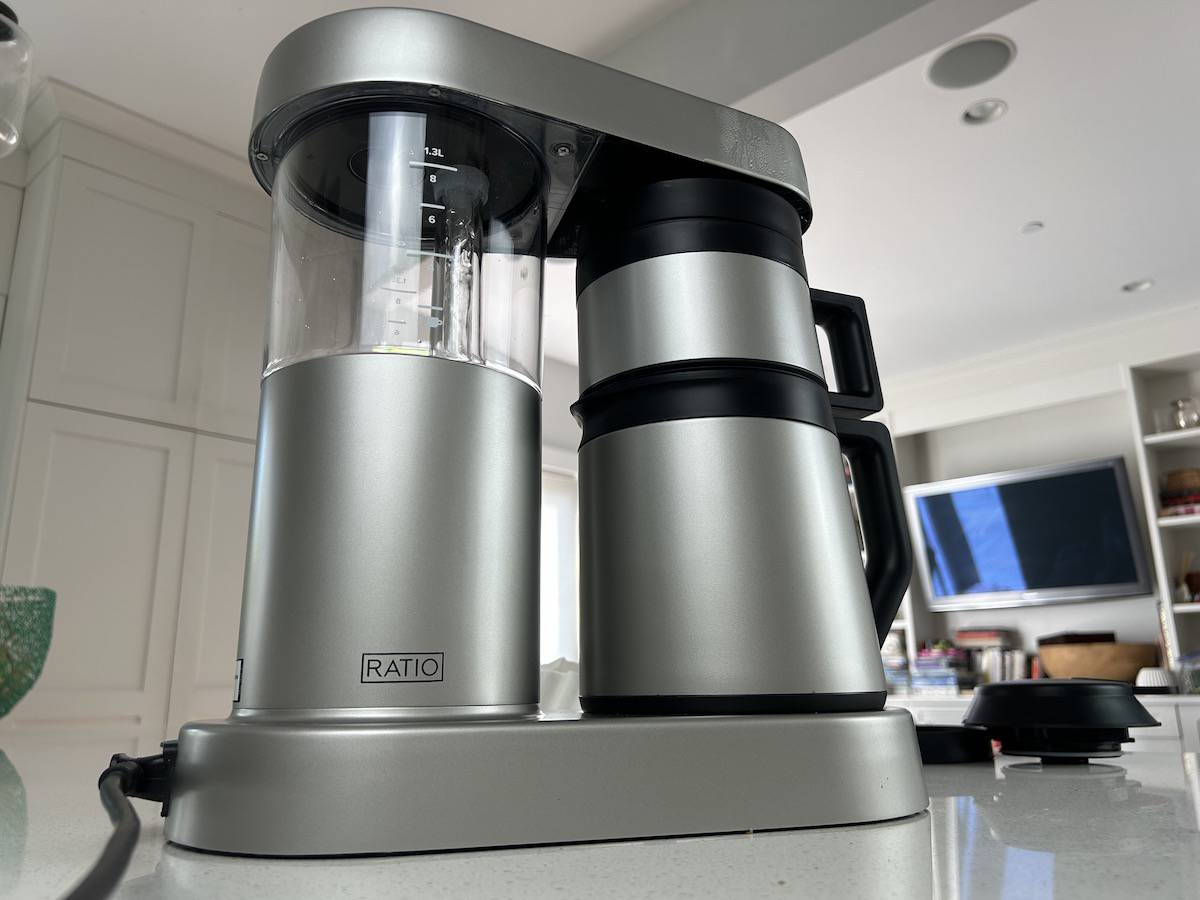
Navigating the landscape of high-end brewers can be daunting. The Ratio Eight’s reputation precedes it, renowned for its unparalleled brew quality and sophisticated design. But the Ratio Six has its own compelling features and promises to bring a top-tier brewing experience at a much more approachable price point.
At first glance, distinguishing the two might feel like splitting hairs. That’s where this review comes in.
I’ll take a close look at this upstart brewer and try to clarify its standing in the premium brewing domain. Is it the understated sibling of the Eight? Or does it have its own tale to tell? Let’s unravel this together.
I’ll go over the Ratio Six’s capabilities and performance for typical household use. May aim is to help you understand its value and determine whether the Ratio Six is the coffee machine to trust with your morning ritual.
Things I Liked
- Sharp-looking design
- Built like a tank
- Easy operation
- Nearly silent while brewing
- Excellent coffee
- 5-year warranty
Things I Didn’t Like
- Tricky to pour from carafe (Update: Since this review was written, Ratio has released the Ratio Six Series 2 with a newly designed carafe lid. I have not tried it, but I strongly suspect it addresses this drawback.)
- Not programmable
- No pause-and-pour feature
- Condensation buildup on machine during brew
Ratio Six
A stylish machine that makes coffee to rival your pour-over.
Place In the Market
The Ratio Six competes with the top automatic drip coffee makers on the market. These brewers are known for their minimalist design and high-quality materials—and allowing anyone to make awesome coffee with just a button click or two.
It’s also certified by the Specialty Coffee Association, which is a significant stamp of approval granted to only a select group of drip coffee makers.
The obvious competitor to the Ratio Six is the Technivorm Moccamaster. You could also throw in other SCA-certified home brewers like the OXO Brew 9-Cup and the Bonavita BV1900TS. I would put the Breville Precision Brewer into this mix as well, although it’s not on the SCA’s list. And something like the Chemex Ottomatic could be considered a reasonable alternative.
The Ratio Six is not a coffee maker for those who just need to make one cup of coffee in the morning. This machine is really intended for batch brewing and is at its best when brewing a carafe for multiple servings.
How It Came About
Ratio is a Portland-based brand started in 2012 by the same folks behind Clive Coffee. It is perhaps best known for its flagship brewer, the Ratio Eight with the glass carafe, which launched in 2015 after a crowdfunding campaign.
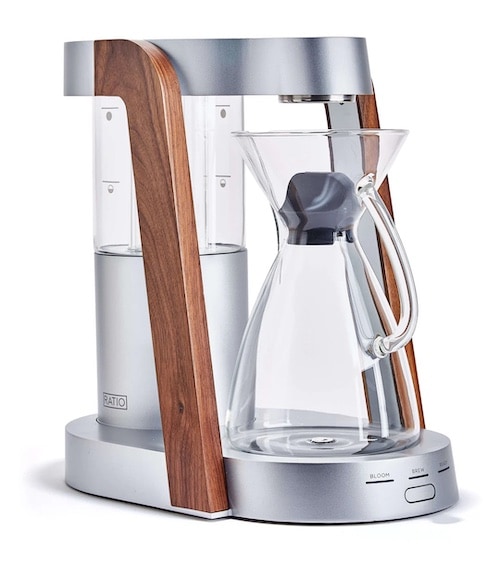
The Ratio Eight is gorgeous and designed with proper science behind it to make incredible coffee. But it’s not cheap. For most people, it’s a machine that you gaze longingly at on Instagram but don’t actually buy.
So in 2019, Ratio decided to make a more affordable version. They launched another Kickstarter campaign, easily raised their seed money, and developed the Ratio Six.
The Ratio Six foregoes some of the high-end materials and fancy tech of the Ratio Eight. It’s not as much of a conversation piece, but it still brews a great cup of coffee and looks far more stylish on your counter than the average drip brewer.
What Makes It Unique
Ratio’s whole thing is to emulate manual pour-over brewing as closely as possible in an automatic drip coffee maker, and do it while looking good.
This is what the Ratio Six is all about. Its stainless steel shower head is world-class. The Ratio Six probably comes closer than any other automatic machine to matching the even saturation you get when you pour manually with a gooseneck kettle.
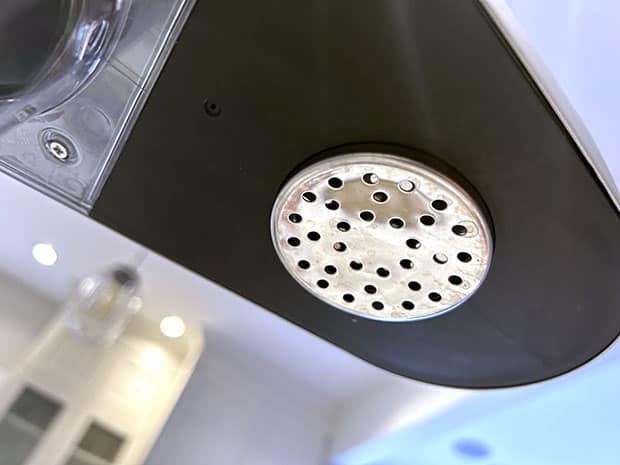
And the angled lines and modern design of this coffee pot are striking enough that it’s bound to get a few remarks from your guests—even if it’s not quite as elegant as the Ratio Eight.
Design and Build Quality
When I lifted the Ratio Six out of its packaging, I could tell instantly that this was the real deal. We’ve all seen coffee makers that look legit at first glance but feel like a Fisher-Price toy in your hands.
The Ratio Six is not that. It has heft. And that brushed-metal casing that covers the base, and the tower, and the top—I was expecting plastic faux-metal simply because I’ve seen it so many times on other machines, but this is actual metal. Stainless steel with a satin finish.
The Ratio Six was designed in Portland, and is assembled there by hand from custom parts made in Taiwan and China.
Yes, there are plastic parts. Anything black that you see in these photos is plastic, but it’s definitely sturdier than the plastic you come across in most coffee makers.
Inside the water reservoir, which is surrounded by a BPA-free copolymer, you’ll see hand-blown borosilicate glass water lines that carry the water through the machine. The designers’ choice of glass over rubber for these tubes almost certainly adds to the machine’s cost, but it also prevents unpleasant flavors or chemicals from leaching into your hot water while it’s on its way to the coffee bed.
The thermal carafe is double-walled and vacuum-sealed, so you can count on it to keep things hot for as long as you need.
Having only had this machine for a short time, I can’t speak to its durability. But it does come with a limited five-year warranty, so my guess is it’s built to last.
The unit I received did have one flaw. You can see in this photo a slight gap where the tower meets the base, as though the tower has been bent or warped slightly inward:
I suspect this is more to do with rough handling than any shoddiness on the part of the manufacturer. Seattle Coffee Gear didn’t charge me for this unit, and perhaps they parted with it because it had been slightly damaged during shipping. I doubt this is a common occurrence.
How To Use The Ratio Six
The Ratio Six works like most automatic coffee brewers, with a few quirks.
Fill the Water Reservoir
The water tank has a heavy stainless steel cap that screws into the top. Simply remove the cap and fill the tank with as much water as you want, using the coffee carafe or another vessel from your kitchen.
A Note About Cup Sizes
The water tank has marks on the side indicating water levels for 2, 4, 6 and 8 cups. Keep in mind that the people who make coffee machines drink much smaller cups of coffee than you and I do! As with most drip coffee makers, a “cup” on this machine is only about 5.5 ounces, which is quite a small cup. So filling to the 2-cup mark will give you 11 ounces, or one good mug of coffee.
The tank’s 8-cup capacity is 1.3 liters, or 44 ounces.
Fill the Filter Basket
Along with the main unit, there are two pieces central to the brewing process: the filter basket and the carafe.
The filter basket takes a standard flat-bottomed filter. A Melitta 8-12 cup basket filter is just about perfect. (The filters that came to me with the machine were a little crumpled, so they don’t look great in the photos!)

You can also use a No. 4 conical filter such as those made by Melitta. It just won’t fit quite as neatly and you’ll have to work the corners into the basket with your hands.
I ground up 36 grams of Harvest Moon, a medium-dark roast blend of Nicaraguan and Sumatran coffee beans from Agro Coffee Roasters in Vancouver. My setting was 45 on the Breville Smart Grinder Pro, just as I use when brewing with my Technivorm Moccamaster.
It’s best to place the filter in the brew basket first, then pour in your ground coffee.
The filter basket nestles easily onto the top of the carafe to create the Ratio Six’s signature “carafe stack.” It’s not hard to tell when it’s in place.
Attach the Heat Shield
The next step is to put the heat shield in place. The heat shield is optional, but it apparently will keep the water five degrees hotter during the brew cycle.
The heat shield is a rubber ring that attaches easily around the rim of the filter basket. It has a “turtleneck” collar that wraps itself around the shower head when everything is in place:
Getting the carafe into place after the heat collar is attached can be a bit awkward. That turtleneck—the key design feature for keeping everything warm—sticks up quite a bit and clashes with the shower head as you slide the stacked unit into place. It’s OK, because the collar is flexible. It simply gives way as you slide everything in. Once it’s fully under the shower head, the collar flips back up to envelop the shower head on all sides.
If you’re bothered by having to delicately wedge everything into place, you are more than welcome to leave the heat collar off. I don’t think it’s going to harm your coffee at all.
Start the Brew
Now that you have your water filled, your coffee ground, and your carafe and filter in place, it’s time to brew!
The Ratio Six has one brew button, located on the end of the base. It’s very sensitive to touch. You don’t have to press it or anything. Just a glancing tap with your finger and the brew cycle will begin.
Above the brew button are three indicator lights to let you know which of the brew phases you’re in: Bloom, Brew or Ready:
Blooming
The “bloom” phase is part of Ratio’s attempt to emulate pour-over brewing with this machine. It allows a limited amount of water to soak the grounds and then pauses the brew cycle for about 15 seconds so the grounds can bloom. Blooming is a chemical process in which hot water removes carbon dioxide from the beans before full brewing begins. It’s an important step when making pour-over coffee with fresh beans.
I was shocked by how much water the bloom cycle used when I brewed four cups. When I make pour-over, I literally just use enough water to dampen the beans. In this case, the Ratio used almost of quarter of the total water—probably five ounces.
The Ratio uses the same amount of water for blooming regardless of how much coffee you’re making. This volume of bloom water would have made sense for a full carafe, but it seems excessive for two or four cups.
The downside is that when you use too much water for blooming, coffee actually drips into your carafe during the bloom phase. And this coffee will contain the carbon dioxide you were trying to get rid of. I mean, it’s not a huge problem, but the reason people try to avoid it is because carbon dioxide carries a slightly sour taste that can affect the taste of the final brew.
Brew time
The Ratio Six’s brew time was comparable to other high-end drip machines—about 4:40 for a 4-cup pot of coffee. This is perhaps a little longer than the Moccamaster, but that’s understandable when you consider the pause after the blooming phase.
How It Performs
The first thing I noticed during the brew cycle was that a lot of steam condensed on the outside edge of the machine’s top, above the carafe and shower head. I’m not too concerned about water gathering on a stainless steel surface, but it’s something I hadn’t really seen on other machines. Worth noting.
Pouring
(Update: The following criticisms of the carafe lid apply only to the original Ratio Six design. Since this review was written, Ratio has released the Ratio Six Series 2 with a newly designed carafe lid. I have not tried it, but I strongly suspect it addresses this drawback.)
And now we come to my only significant complaint about the Ratio Six: The carafe does not pour very well.
After brewing, you remove the carafe stack from the machine and lift off the filter basket. You can place it on a handy circular pad that comes with the machine to catch any drips.
Then you seal the carafe with its plastic lid, also provided. You drop the lid on top, give it a little less than a quarter turn, and it locks into place. It takes some getting used to, but you’ll know when you’ve got it right.
The lid has a thumb tab that sticks out above the carafe’s handle when everything is in place. I pressed this tab and began pouring into my cup.
It was a gong show. The coffee came out like it was drunk:
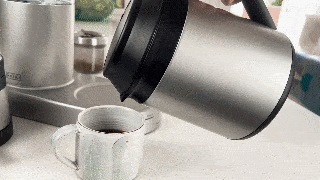
It wasn’t until later that I noticed a little sticker on the handle of the carafe advising that the carafe should be angled for pouring before you depress the thumb tab. With a little experimentation, I learned to tip the closed carafe at a 90-degree angle above my cup and then slowly depress the thumb tab to get the coffee flowing. If you do this, you can achieve a steady stream that doesn’t make a mess:
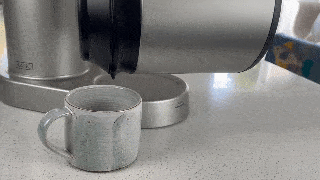
It’s not very intuitive, and I have a hunch that little sticker was added after the fact, once they realized what a mess the carafe makes when people pour the way they’re used to pouring.
Quality of Coffee
We come to the big question: Does the Ratio Six make good coffee?
I’ll answer with an emphatic yes. It produced a bold, rich cup without any off-putting notes. Maybe not quite as good as my manual pour-over methods like Hario V60 and Chemex, but at least equal to the Moccamaster which I consider the gold-standard automatic coffee maker.
Remember, this was for a medium-dark roast which is a little harder to screw up than a light or medium roast. My next test will be to see how well the Ratio Six brings out the nuanced flavors of those coffees. Based on the delicious coffee I’ve already had, I suspect it will do just fine.
Heat Retention
I don’t like keeping coffee on a burner for too long because it tends to impart some unpleasant, burnt flavors. So the Ratio Six’s thermal carafe was welcome.
However, you may want to enjoy a cup of coffee a couple of hours after brewing, so the carafe needs to retain heat well.
I can report that when I brewed five cups of coffee into the Ratio Six’s insulated carafe, it was still at a nice, hot drinking temperature three hours after brewing. However, when I brewed three cups it was quite cool after three hours. It seems the the more coffee you brew, the longer it remains hot.
You may start to lose heat after two hours depending on how much you brew—but hey, who wants to drink coffee that’s more than two hours old anyway?
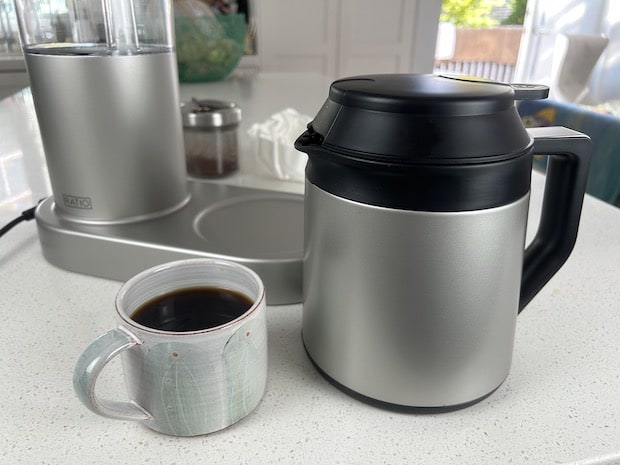
Noise
The Ratio Six is an extremely quiet brewer. The only sound you hear while it’s making coffee is the water gurgling up through the glass tubes toward the shower head.
Your grinder might wake up the house, but your brewer will not.
What It’s Missing
Pause and Serve
Pause-and-serve is a feature of many automatic drip coffee machines, but the Ratio Six doesn’t have it—at least not in the way you’d expect.
You can grab the carafe and remove it in the middle of the brew cycle, but here’s what will happen:
- You will get a few seconds of dripping from the shower head before it stops.
- The brew cycle will end and all lights will turn off.
- If you try to resume brewing by hitting the brew button, you will begin the entire cycle again, starting with the bloom phase
The Ratio Six isn’t designed for you to pour yourself a quick cup and then instantly pick up brewing where you left off. Yes, it can detect when the carafe is gone and will cease brewing so as not to make a mess, but at that point you’re basically going to have to start over.
It’s fine in a pinch, but I recommend letting the whole cycle run before you pour yourself a cup.
Programmability
There is no timer or programmability on the Ratio Six. You need to be awake and hands-on in order to brew your coffee.
What It Comes With
Thermal carafe: This seems reasonably well-insulated and looks good with its satin stainless steel exterior.
Carafe lid: This is made of black plastic and is set aside during brewing, then attached afterward.
Filter basket: Satin stainless steel and black plastic, designed to stack neatly on top of the carafe for brewing.
Heat collar: A rubber attachment that goes around the rim of the filter basket and helps insulate the space between the shower head and filter as the coffee brews.
Filter tray: Made of the same black plastic as the carafe lid, it’s a resting spot for the filter after you’ve brewed the coffee and will catch any remaining drips.
Power cord: It’s a three-foot cord with a thoughtful L-shaped attachment to the machine so that it doesn’t stick out at right angles. A nice touch.
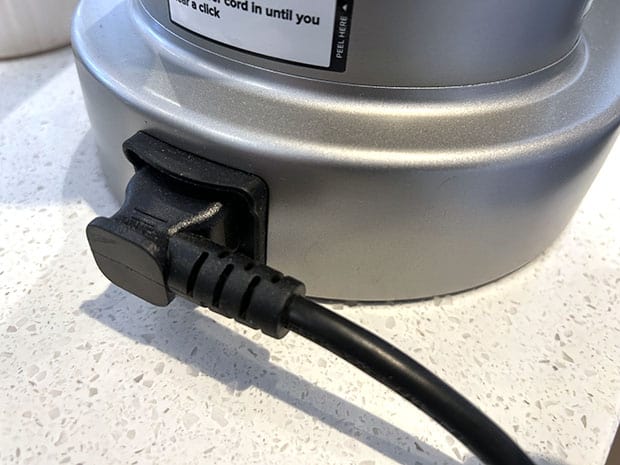
Note that the satin stainless steel finishes described above are for the demo model I received in brushed stainless steel. The Ratio Six also comes in a matte black or white version.
Cleaning and Maintenance
Day-to-day cleaning of the Ratio Six is easy and straightforward. Just give the filter basket, carafe and their plastic accessories a good rinse by hand after you’ve finished your coffee, then let them dry. You can use dish soap if you want, but the parts should not go in the dishwasher.
All drip coffee makers, including the Ratio Six, are susceptible to limescale buildup in the pipes that carry the water. This comes from minerals in the water. It’s a bigger problem in some locations than others, because some water systems have higher mineral content.
You want clean lines, so it’s best to keep up with this next bit of maintenance.
Ratio endorses a cleaning product called Halefresh that can be used to clean and descale the lines. You just run it through the machine’s brew cycle once a month or so (more frequently if your water is really hard) and then run a couple more cycles of water to rinse it.
You don’t have to use their product, though. Some people use a mixture of one part vinegar to two parts water. If you don’t want to risk a lingering vinegar taste, then citric acid is a great alternative. You can buy it in powdered form from many wine- and beer-making shops. Two tablespoons of citric acid dissolved in a liter of water is perfect for descaling your machine.
Specifications
| Dimensions | 13.5″ x 6.75″ x 14.25″ (H) |
| Weight | 8 pounds |
| Materials | Stainless steel, BPA-free plastic, borosilicate glass |
| Brewing capacity | 1.3 L or 44 ounces |
| Heating power | 1400 W |
An Impressive Machine Despite Its Flaws
The Ratio Six makes great-tasting coffee and looks very stylish on your counter. I think those are the two things they were really trying to achieve with this machine, so mission accomplished.
I always wonder why people who put so much time and effort into developing a high-end machine aren’t able to stick the landing. This machine ought to pour like a dream, but it doesn’t. (They were so close!)
But hey, I’m a fast learner and it only took a few brews to figure out how to pour without a making mess. You’ll figure it out, too. And then you’ll have a pretty nice coffee machine on your hands.

